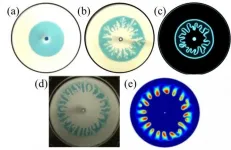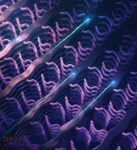(Press-News.org) The international collaborative team of Tokyo University of Agriculture and Technology (TUAT) in Japan and Indian Institute of Technology Ropar (IIT Ropar) in India has explored, for the first time, viscous fingering (VF, one of classical interfacial hydrodynamics) of annular ring where VF in fluid of finite volume grow radially through combination of experiment and numerical simulation. They demonstrate that the VF of an annular ring is a persistent phenomenon in contrast to the transient nature of VF of a slice where VF in fluid of finite volume grow rectilinearly.
The researchers published their results in the Journal of Fluid Mechanics on Apr 6th, 2021.
When a less viscous fluid moves in a more viscous fluid in porous media, the interface between the two fluids becomes unstable and deforms in a finger shape. This phenomenon is technically called "Viscous fingering (VF)". Since the 1950s, the VF has been studied as one fluid dynamics issue. VF can be classified according to whether the less viscous fluid displace the more viscous one rectilinearly or radially.
"Classically, VF formed at an interface between two semi-infinite domains of different viscosity have been studied. However, recently, VF formed at either the front or the rear interface of the fluid of finite volume has attracted attention because such VF is relevant to chromatography, spreading of groundwater contamination, and enhanced-oil-recovery. So far, VFs formed in finite volume fluids in linear geometry have been mainly studied only by numerical simulation. However, VFs formed in finite volume fluids in radial geometry have been rarely studied experimentally or numerically." said Dr. Nagatsu, one of the corresponding authors on the paper, Associate Professor in the Department of Chemical Engineering at Tokyo University of Agriculture and Technology (TUAT). "This is because of the complexity of creating finiteness in experiments and difficulties in numerically solving the governing equations."
The research team succeeded in integrated analysis experiments and numerical simulation on VF formed in finite volume fluids in radial geometry (see Figure). The experiments are carried out using a water- glycerol miscible system in a Hele-Shaw cell which is an experimental apparatus to mimic the porous medium flows. The simulation is done using the two-phase Darcy law (TPDL) module of COMSOL (COMSOL Multiphysics®).
"Our team found that the VF of an annular ring is a persistent phenomenon in contrast to the transient nature of VF of a slice (see Figure). Although new fingers cease to appear after some time but due to the radial spreading of the area available for VF, a finite number of fingers always remain at a later time. Furthermore, we clearly showed that VF was observed only if the width of the finite layer exceeds some value," Nagatsu explains.
"Apparently our results shows that the dynamic of VF in annular ring is dramatically different from those classical radial VF and rectilinear VF with one fluid sandwiched between layers of another. VF in annular actually takes place in spreading of groundwater contamination, and enhanced-oil-recovery. Thus, our finding is expected to enable us to make highly accurate prediction of such processes," adds Nagatsu.
INFORMATION:
For more information about the Nagatsu laboratory, please visit http://web.tuat.ac.jp/~nagatsu/en/index.html
For more information about the Mishra laboratory, please visit http://www.iitrpr.ac.in/FD/Home.html
Original publication
Viscous fingering of miscible annular ring
Vandita Sharma, Hamirul Bin Othman, Yuichiro Nagatsu and Manoranjan Mishra
Journal of Fluid Mechanics, 916, A14.
https://doi.org/10.1017/jfm.2021.124
Acknowledgements. M.M. gratefully acknowledge the JSPS Invitation Fellowships for Research in Japan (no. L19548). M.M. and V.S. thank Global innovation research, Tokyo University of Agriculture and Technology (TUAT) and Y. Nagatsu for providing the local support during the research stays at TUAT. M.M. acknowledges the financial support from SERB, Government of India through project grant number MTR/2017/000283.
About Tokyo University of Agriculture and Technology (TUAT)
TUAT is a distinguished university in Japan dedicated to science and technology. TUAT focuses on agriculture and engineering that form the foundation of industry, and promotes education and research fields that incorporate them. Boasting a history of over 140 years since our founding in 1874, TUAT continues to boldly take on new challenges and steadily promote fields. With high ethics, TUAT fulfills social responsibility in the capacity of transmitting science and technology information towards the construction of a sustainable society where both human beings and nature can thrive in a symbiotic relationship. For more information, please visit http://www.tuat.ac.jp/en/.
About Indian Institute of Technology Ropar (IIT Ropar)
Indian Institute of Technology Ropar (IIT Ropar) is a premier engineering, science, and technology institute in India established in 2008 by the Ministry of Education, Govt. of India (formerly: Ministry of Human Resource Development (MHRD), Govt. of India). IIT Ropar has initiated research on socially relevant problems like water and air pollution, affordable point-of-care healthcare technologies, and artificial intelligence applied to solve future engineering challenges. IIT Ropar has made active research collaborations with the likes of MIT, SUNY, Cardiff University, Cambridge University to name a few. Department of Science of Technology (DST), Govt of India, has established a Technology Innovation Hub (TIH) in the application domain of Agriculture & Water, named as Agriculture and Water Technology Development Hub (AWaDH), at IIT Ropar in the framework of National Mission on Interdisciplinary Cyber-Physical Systems (NM-ICPS). The high standard of research has ensured that year-after-year IIT Ropar has the best research performance amongst newer IITs, in India and in world rankings like the QS Asia rankings (205th) and Times Higher Education World University rankings (301-350). The institute has made significant research investment in Industry 4.0 in partnership with the Government of Taiwan by setting up the Indo-Taiwan Joint Research Centre on Artificial Intelligence and Machine Learning, a one of its kind in India. For more information, please visit http://www.iitrpr.ac.in
Contact
Yuichiro Nagatsu, Ph.D.
Associate Professor, Department of Chemical Engineering, TUAT, Japan
nagatsu@cc.tuat.ac.jp
Manoranjan Mishra, Ph.D.
Associate Professor, Department of Mathematics, Indian Institute of Technology Ropar, India
manoranjan@iitrpr.ac.in
New research evaluating the drugs commonly used by rheumatoid arthritis patients suggests two combinations could reduce the risk of heart attack and strokes.
The new publication in Frontiers in Cardiovascular Medicine has found that anti-rheumatic drug regimens that include either tumour necrosis factor inhibitors or hydroxychloroquine might significantly protect the endothelium in rheumatoid arthritis.
Occurring in about one in 100 people, rheumatoid arthritis (RA) is a common autoimmune disease which leads to inflammation and pain in the connective tissue of a patient's joints.
"Rheumatoid arthritis patients have an increased ...
A research collaboration based in Kumamoto University (Japan) has shown that lysine-specific demethylase 1 (LSD1), an enzyme involved in gene expression, produces individualized metabolism depending on the type of acute myeloid leukemia cells. Cancer cells are known to have a unique ability to metabolize substances differently from normal cells, and this ability is considered to be a promising therapeutic target. The new research findings may contribute to the safe and effective use of LSD1 inhibitors as potential anticancer agents, and to the development of highly specific treatments for various ...
Researchers have devised a way to multiply by more than ten-fold the accessible details of gene activity in individual cells. It's a big leap in the effort to understand cancer development, brain function, immunity and other biological processes driven by the complex interactions of multitudes of different cell types.
Organs and tissues are made up of cells that may look the same, but individual cells can actually differ dramatically. Single-cell analysis allows the study of this cell-to-cell variation within an organ, tissue or cancerous tumor. But the research has been hampered by limits on the depth of information that can be gleaned at the single-cell level when working with large numbers of cells.
"The downside has been the low-quality of ...
Most of us are familiar with the fact that women live longer than men. But fellas, if we told you there was one thing that could be done to increase your lifespan, would you do it?
In a study published today in eLife , University of Otago researchers along with collaborators from the United States, have shown that castration of male sheep delays aging of DNA compared to intact males, and that it also drives feminine characteristics of DNA and the chemical tags it holds, known as DNA methylation.
"Both farmers and scientists have known for some time that castrated male sheep live on average much longer than their intact counterparts; however, this is ...
Three mutations in the Epsilon coronavirus spike protein dampen the neutralizing potency of antibodies induced by current vaccines or past COVID infections.
The mutations give this coronavirus variant of concern a means to totally evade specific monoclonal antibodies used in clinics and reduce the effectiveness of antibodies from the plasma of vaccinated people.
To better understand the exact immune escape strategies at work here, the scientists visualized this variant's infection machinery to see what is different from the original configuration of the pandemic coronavirus, and what the implications of these changes are.
The international project was led by David Veesler's lab in the Department of Biochemistry at the University of Washington ...
In a retrospective, multi-centre cohort study conducted by researchers from Nanjing University, Huazhong University of Science and Technology, Jinling Hospital and the Second Hospital of Nanjing, a microRNA-like small RNA encoded by SARS-CoV-2 was identified in the serum of COVID-19 patients, which can be developed as a non-invasive biomarker for stratification of severe patients from mild/moderate ones and for identification of high-risk individuals before clinical manifestation of severe symptoms. This biomarker ensures proper allocation of patients to different ...
A research team, led by Professor Dai-Sik Kim in the Department of Physics at UNIST has developed a new technique of predefining the crack pattern on a flexible substrate by a sequential deposition of metallic layers which leads to a formation of a "zero-nanometer gap, or a "zerogap," between the adjacent lateral patterns.
These gaps, according to the research team, readily open and recover with gentle bending and relaxing of the flexible substrate, precisely along the rims of the pre-patterns of centimeter lengths. Furthermore, in a prototypical pattern of densely packed slit arrays, these gaps serve as antennas achieving transparency for polarizations perpendicular to the length of the gap when opened ...
Chemical elements make up pretty much everything in the physical world. As of 2016, we know of 118 elements, all of which can be found categorized in the famous periodic table that hangs in every chemistry lab and classroom.
Each element in the periodic table appears as a one-, two-letter abbreviation (e.g. O for oxygen, Al for aluminum) along with its atomic number, which shows how many protons there are in the element's nucleus. The number of protons is enormously important, as it also determines how many electrons orbit the nucleus, which essentially makes the element what it is and gives it its chemical properties. In short, the atomic number is an element's ID card.
The periodic table ...
A new organic (carbon-based) semiconducting material has been developed that outperforms existing options for building the next generation of biosensors. An international research team led by KAUST is the first to overcome some critical challenges in developing this polymer.
Much research effort is currently expended into novel types of biosensors that interact directly with the body to detect key biochemicals and serve as indicators of health and disease.
"For a sensor to be compatible with the body, we need to use soft organic materials with ...
Networks of ground-based sensors paired with airborne drones could give firefighters a critical edge when battling wildfires, KAUST researchers have found. The sensor/unmanned aerial vehicle (UAV) network could significantly shorten the time taken to detect a wildfire, giving firefighters a better chance to contain the fire before it grows too large to control.
Wildfire detection is currently performed mainly by satellite imaging and remote cameras, but these technologies can be impeded by cloudy weather and fires can grow to a considerable size before they are spotted. With the recent significant global ...





